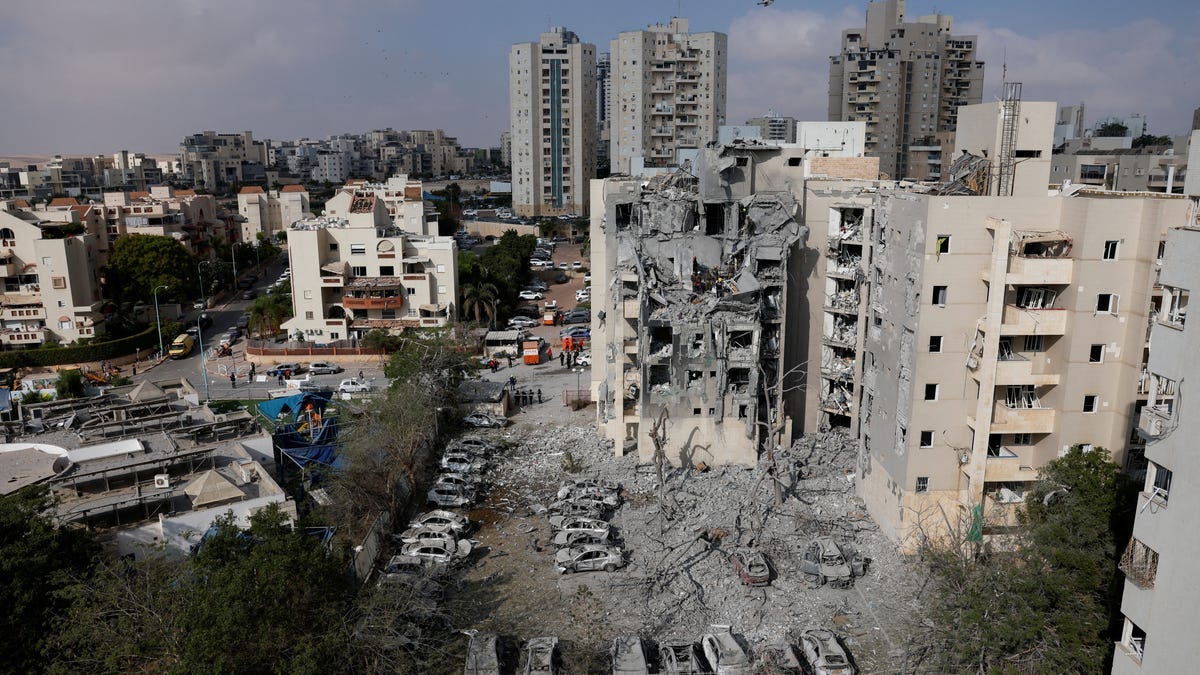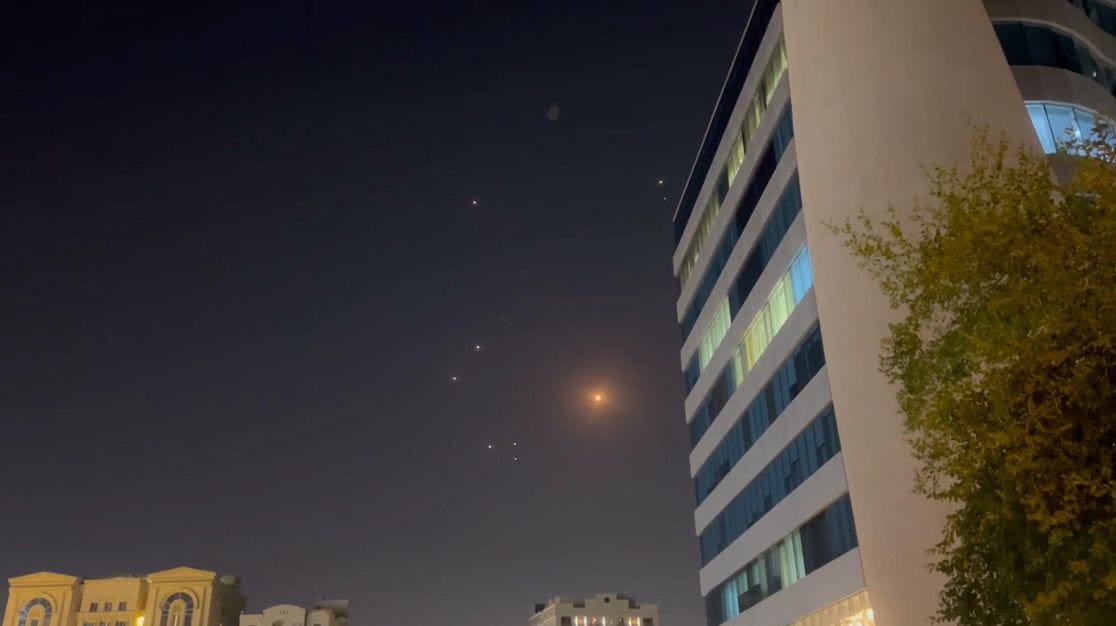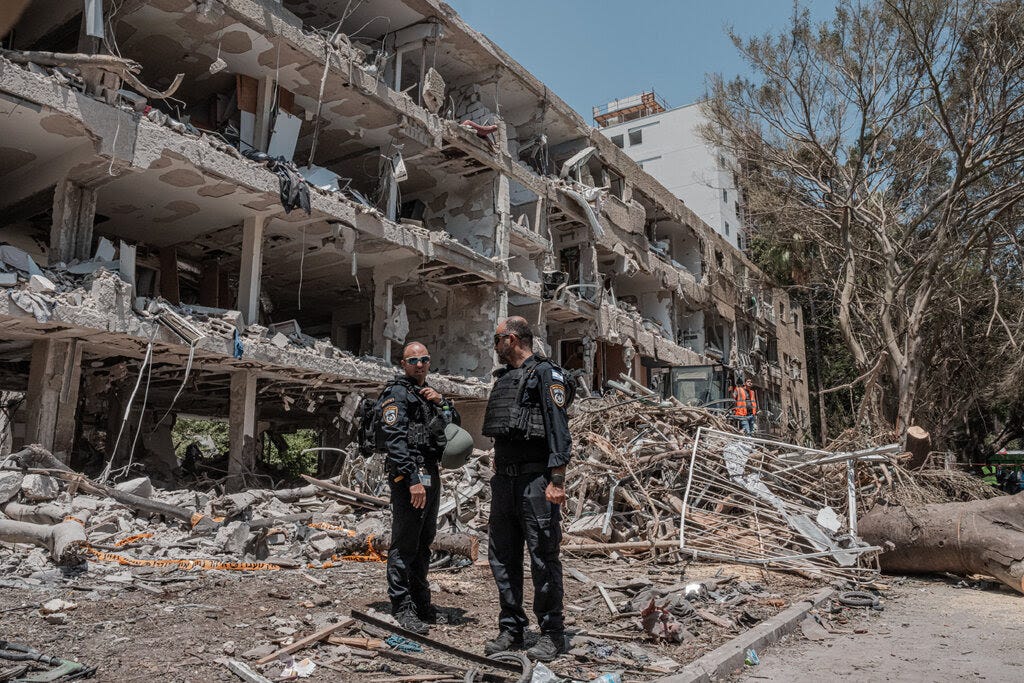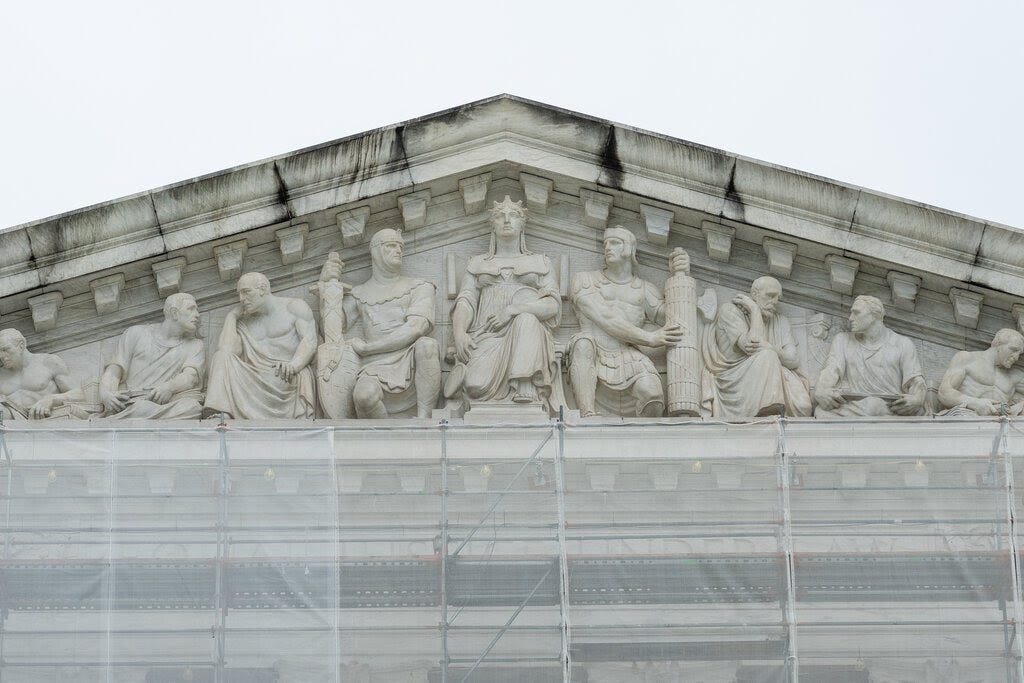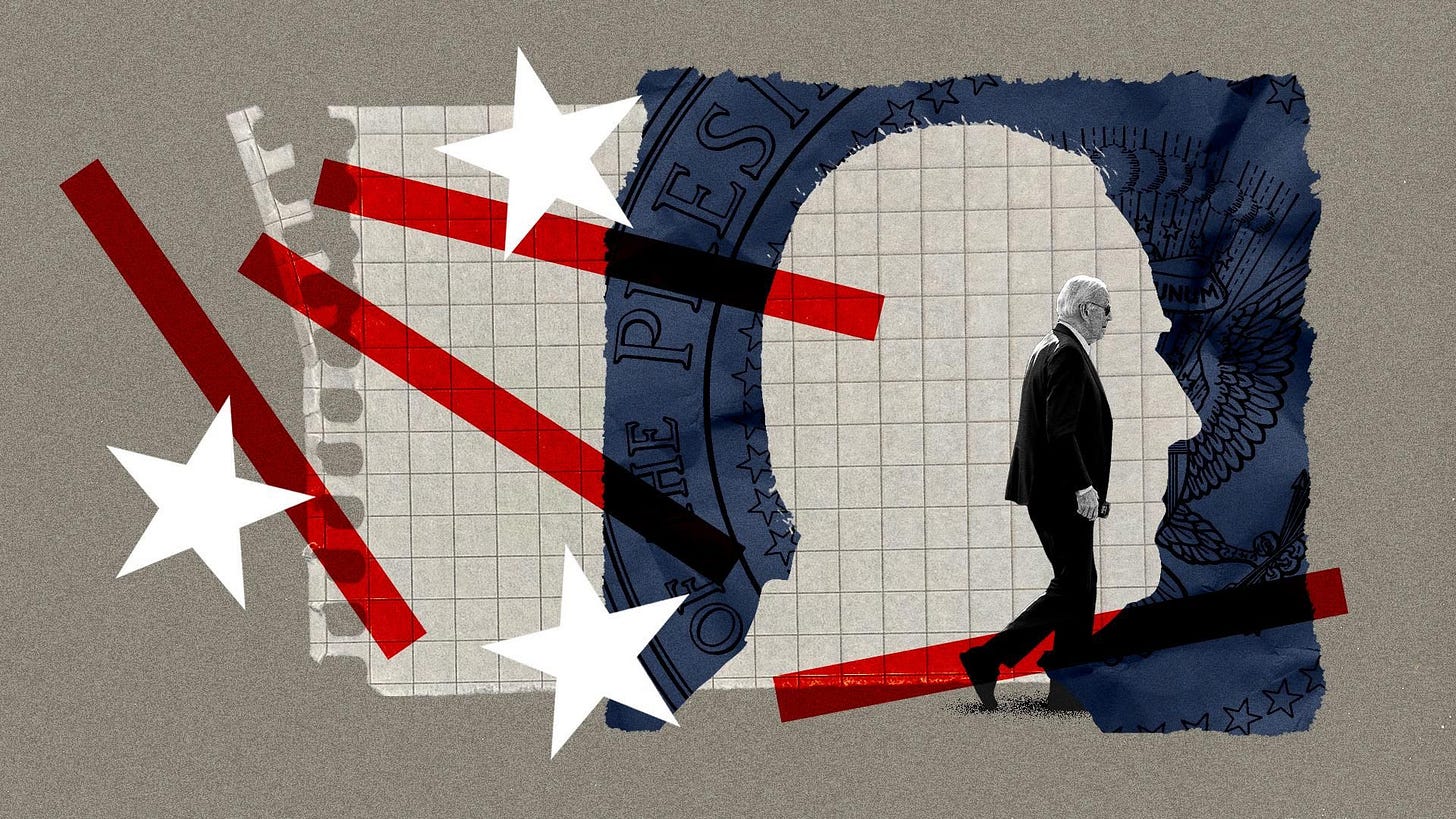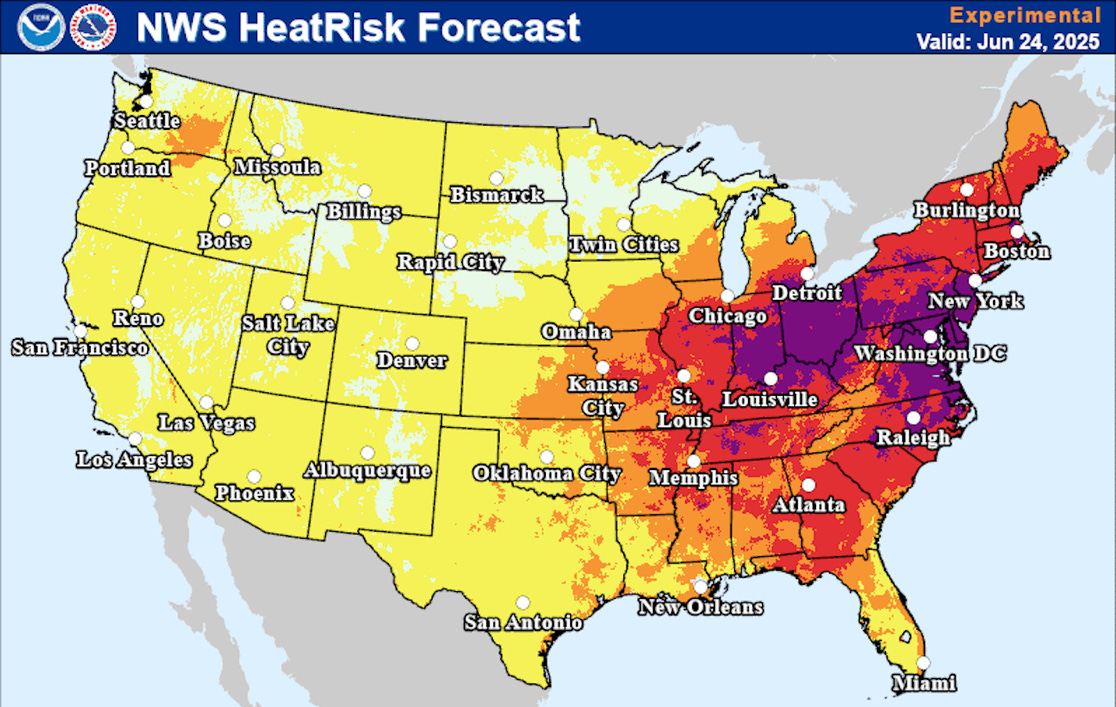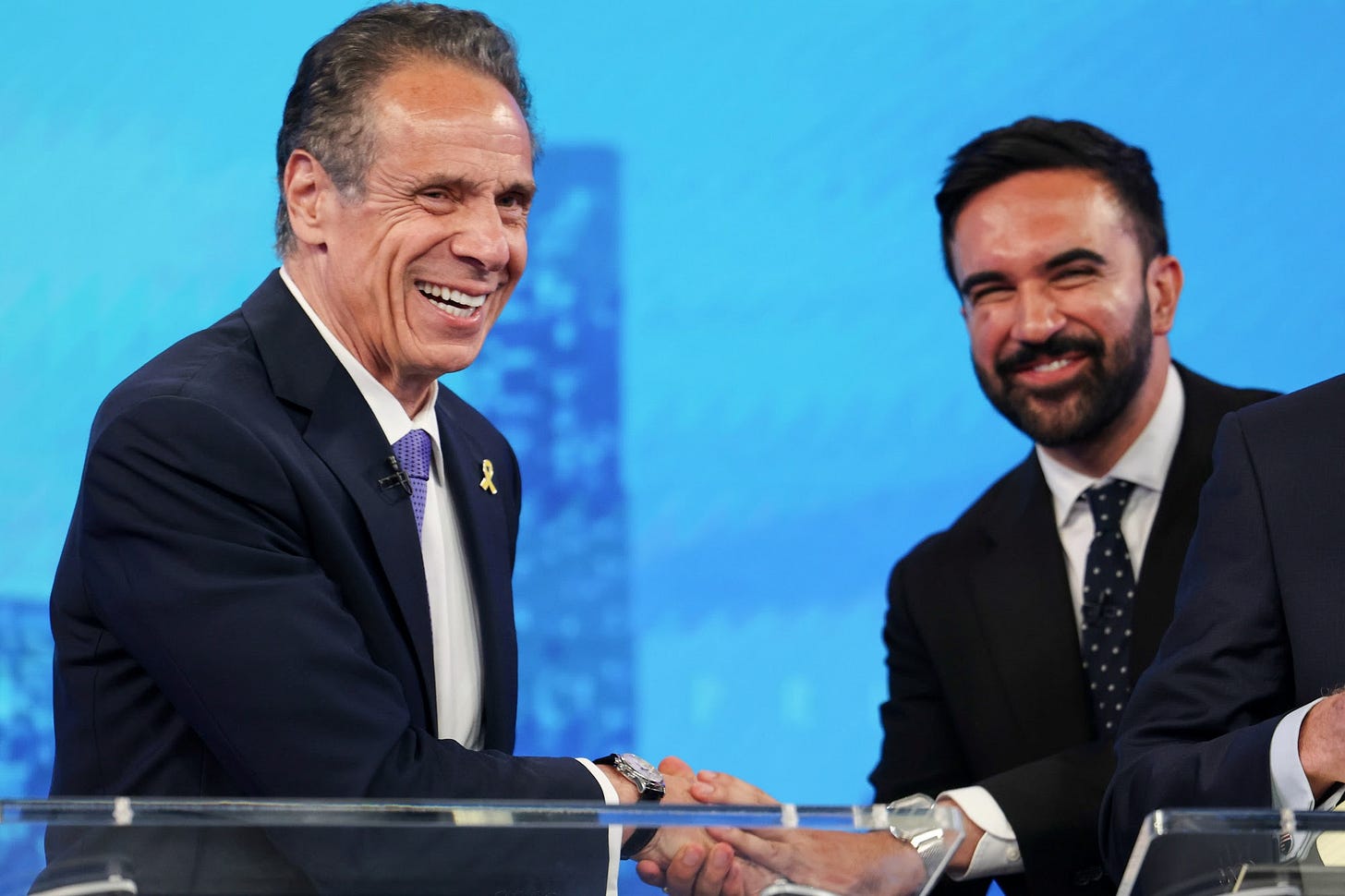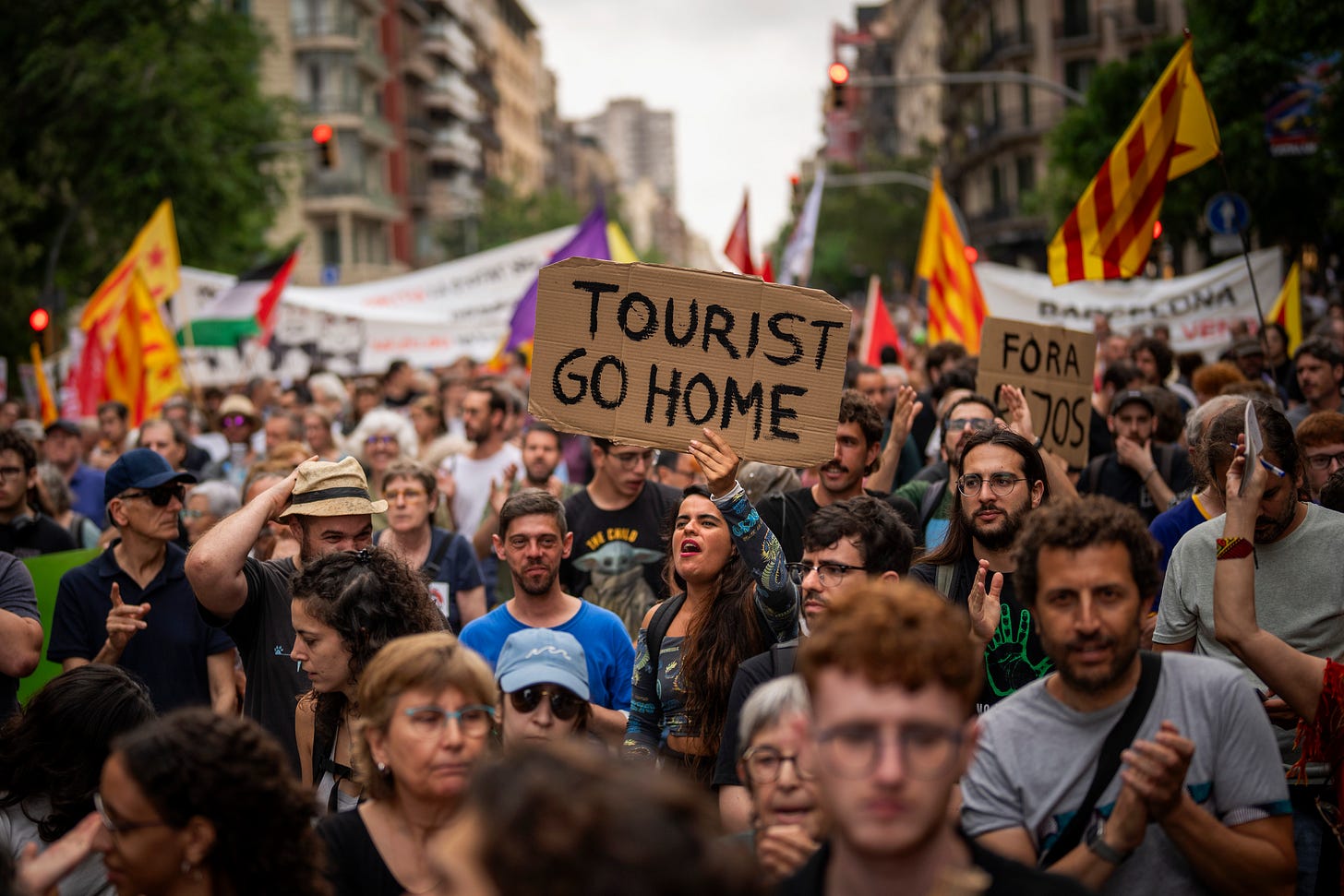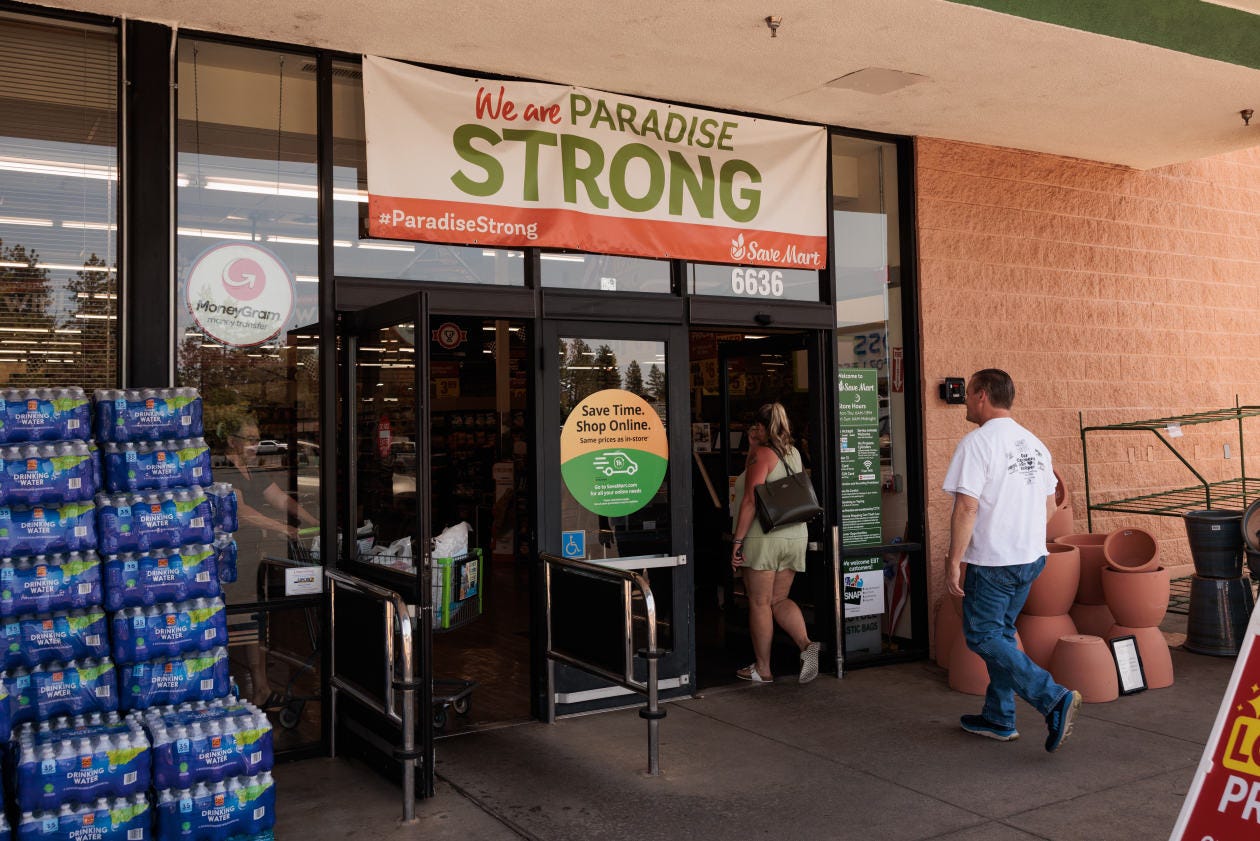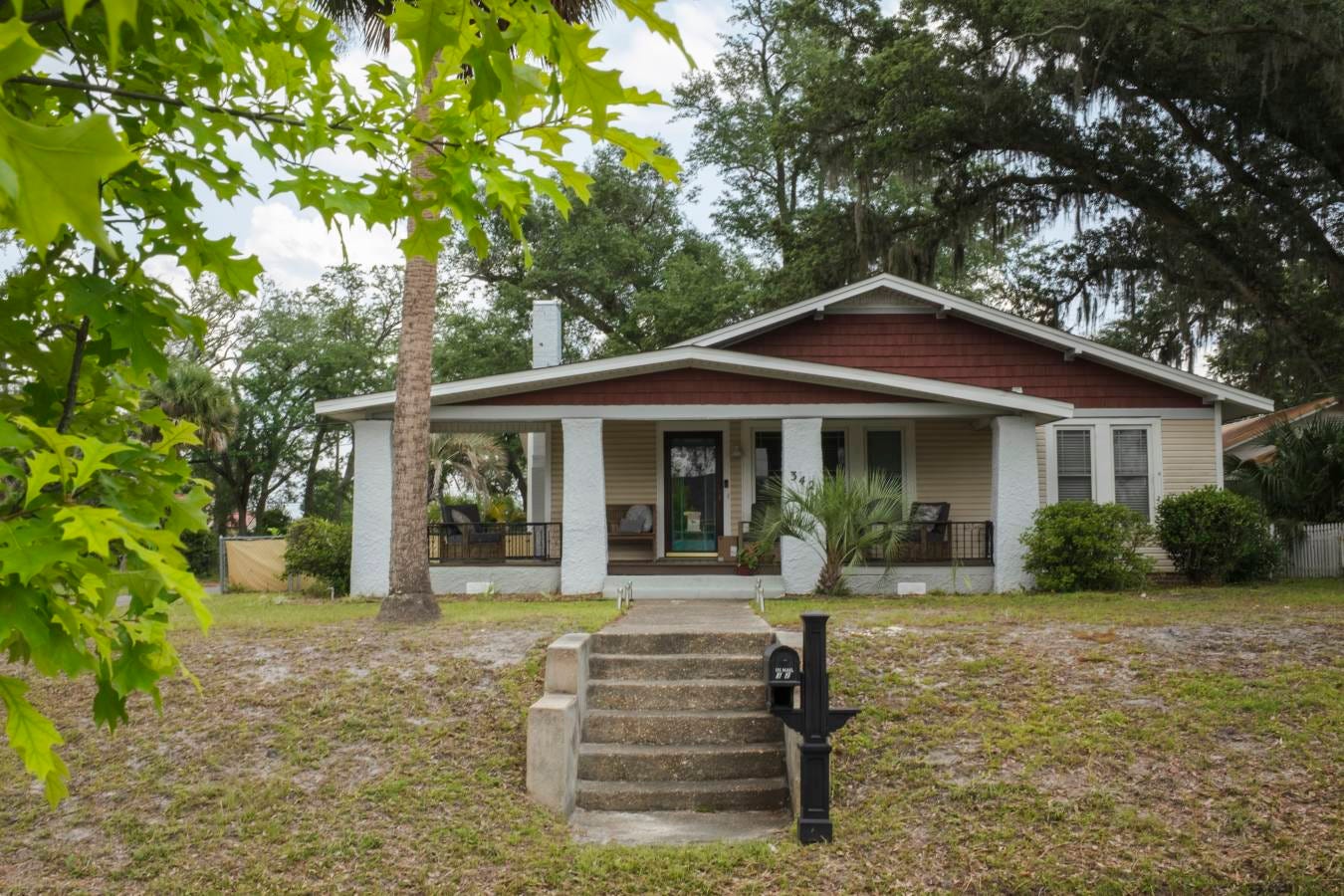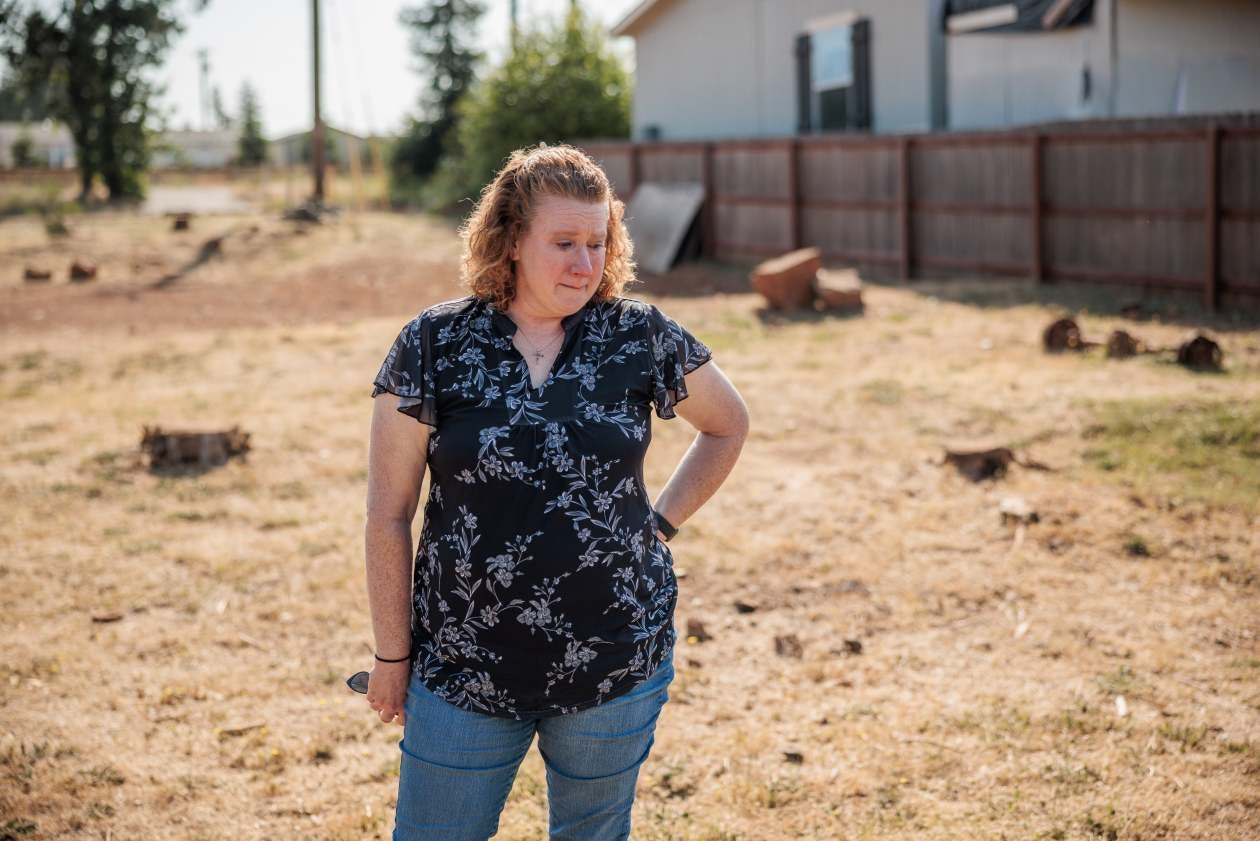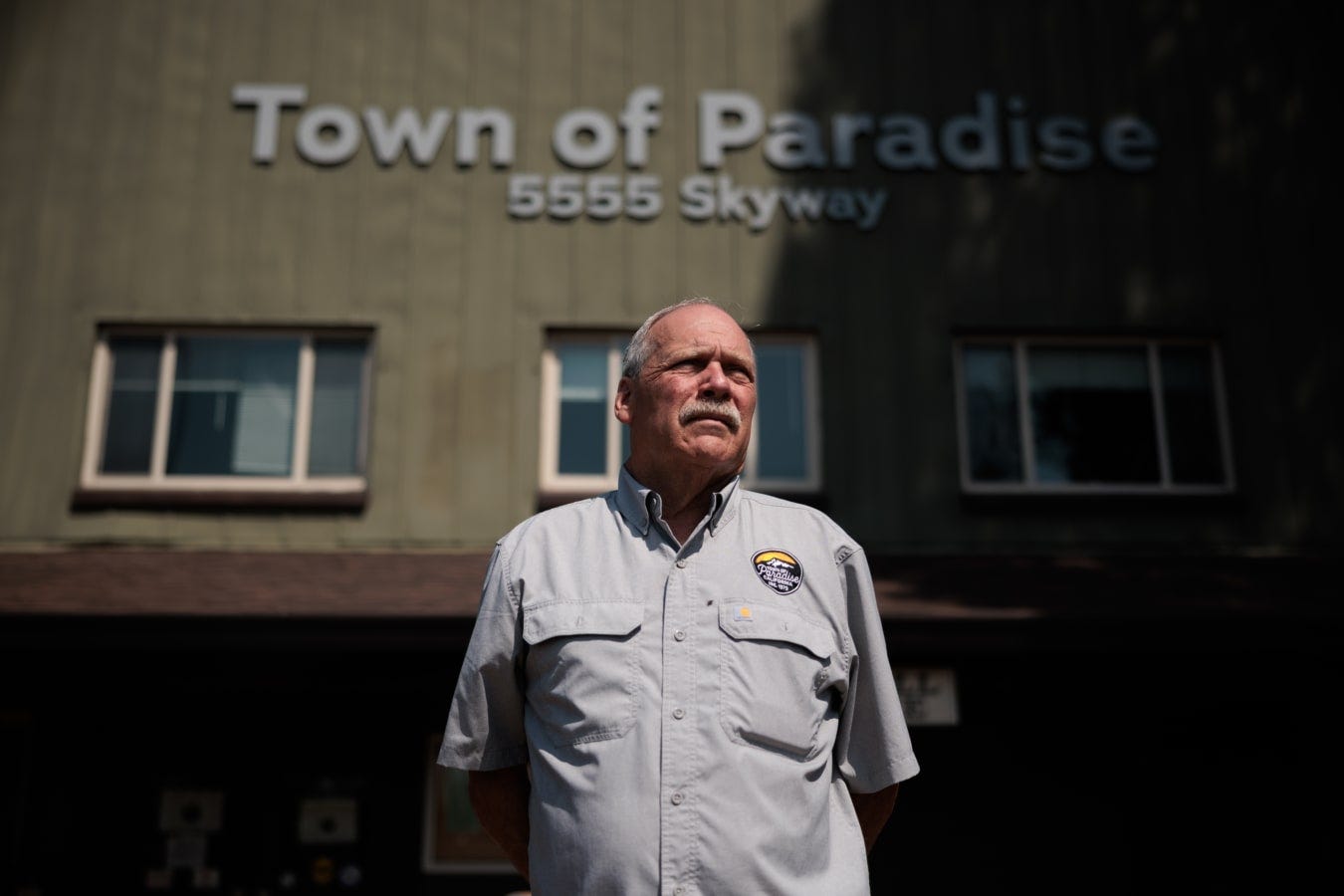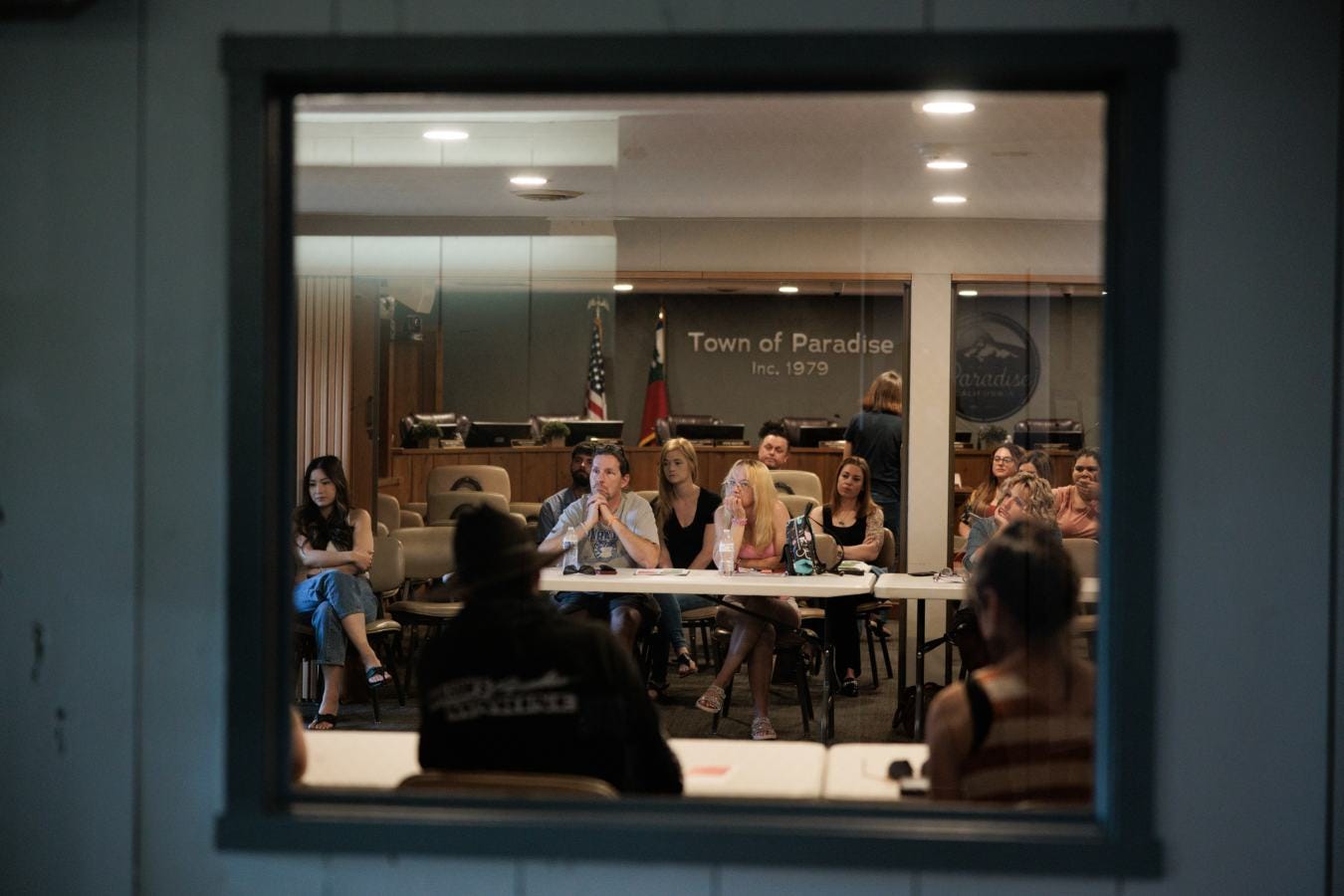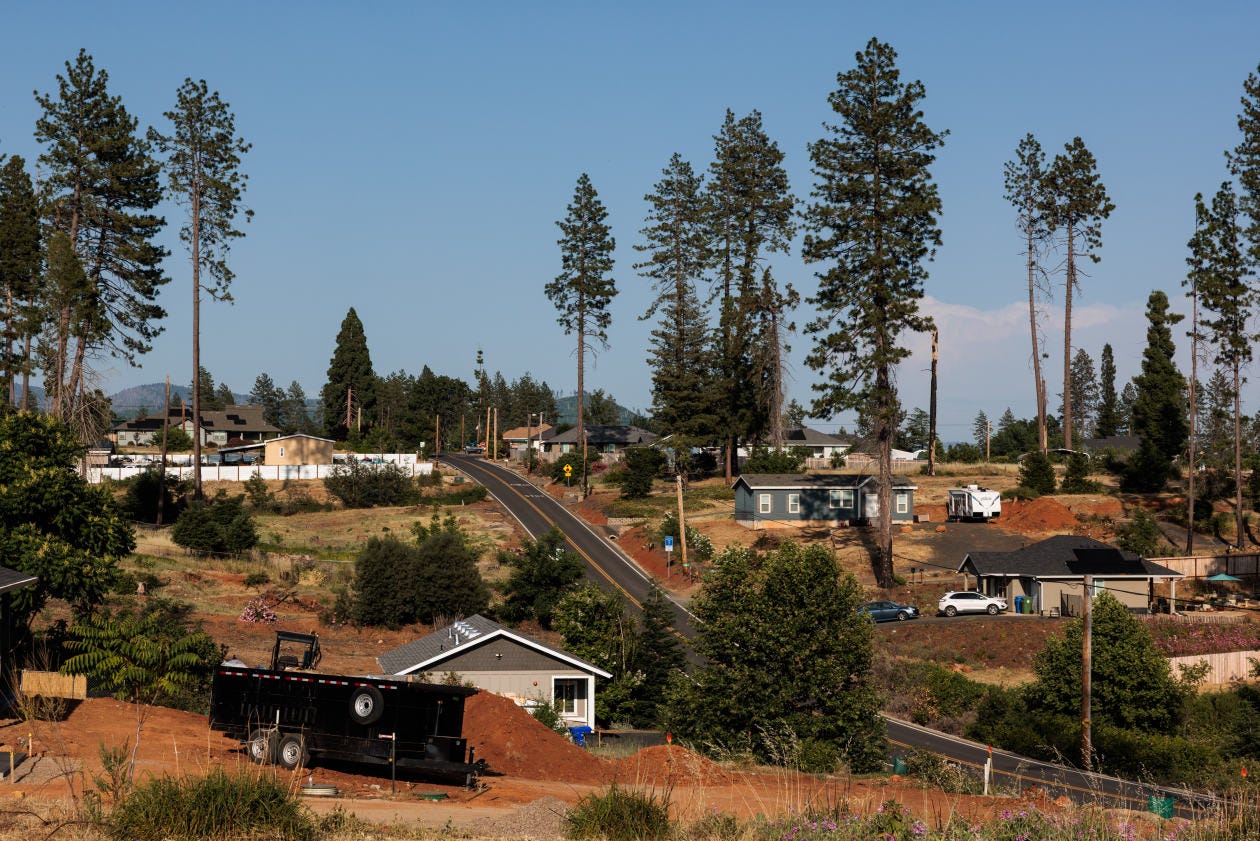Israel vows forceful response, says Iran violates Trump ceasefire: Updates
READ FULL STORY→ USA Today
1 big thing: How the ceasefire happened
Missiles and air-defense interceptors over Qatar yesterday after Iran launched an attack on U.S. forces at Al-Udeid Air Base. Framegrab from video: Getty Images
“The Trump-brokered ceasefire between Iran and Israel has, for now, brought an abrupt and extraordinary end to one of the Middle East's most explosive confrontations in decades, Axios' Barak Ravid and Zachary Basu write.
Why it matters: The 12-day war sent shockwaves through a region already reeling from nearly two years of historic volatility and violence, beginning with Hamas' Oct. 7 terrorist attack on Israel.
President Trump's military intervention to destroy Iranian nuclear sites brought the U.S. to the precipice of a major conflict that four of his predecessors had sought to avoid.
But it set the stage for a ceasefire that — if it holds — could usher in a fundamentally new era for the Middle East, its security and its dominant powers.
Trump told Axios' Barak Ravid in a phone call: ‘This is the end of the war. It is a great and wonderful thing for Israel and the world.’
How it happened: Trump announced on social media at 6:02 p.m. ET that Israel and Iran had agreed to a ‘Complete and Total CEASEFIRE,’ ending ‘what should be called, 'THE 12 DAY WAR.’
Iran responded with mixed signals, but state TV later said the ceasefire was in effect. Just a few hours ago, around 2 a.m. ET, Israeli Prime Minister Benjamin Netanyahu confirmed Israel agreed to a ceasefire with Iran in coordination with Trump.
The situation remains dangerous: Israel is accusing Iran of breaking the ceasefire. For several hours before the ceasefire came into effect — and for several minutes after — Iran fired multiple missile barrages at Israel that killed civilians, threatening to upend Trump's deal.
Behind the scenes: Trump's efforts to end the war began in earnest on Saturday, shortly after U.S. B-2 bombers launched 14 massive bunker-buster bombs that almost completely destroyed Iran's three main nuclear facilities.
The president instructed Steve Witkoff, his special envoy to the Middle East, to communicate to the Iranians his desire to negotiate a deal to end the war, according to a White House official.
Iran initially refused to engage and said diplomacy would be possible only after it exacted revenge by striking U.S. targets, a source with direct knowledge said.
But prior to launching yesterday's missile attack on the Al-Udeid Air Base in Qatar, Iran sent messages to the U.S. — via Qatar — conveying when and what targets they intended to strike, a White House official said.
Immediately after the strike, which left no casualties, the Iranians sent another back-channel message notifying the White House that they would not conduct any further attacks on U.S. targets.
The White House responded — again via the Qataris — saying the U.S. wouldn't retaliate to the Iranian attack, and reiterating its readiness to resume negotiations.
Zoom in: The war ended with Iran at its weakest point since its devastating eight-year war with Iraq in the 1980s.
Israeli and U.S. officials both claim that it will take Iran years to rebuild its military power, reestablish its proxy network and restore its deterrence.
Iran's nuclear program has likely been set back by years — and now faces the threat of further U.S. and Israeli military action if the regime seeks to rebuild it.
Data: Congressional Research Service, CFR. Map: Axios Visuals
Between the lines: A White House official argued that it was the U.S. strike on Iran's nuclear facilities that ultimately created the conditions for ending the war.
‘The Iranians understood Trump wasn't playing games and the Israelis were grateful that Trump did something they couldn't do on their own — and couldn't say no when he asked them to stop,’ the White House official said.
The bottom line: For a president who promised deals but has struggled to end the conflicts in Ukraine and Gaza, the Iran-Israel ceasefire would represent a massive success in his doctrine of ‘peace through strength.’” [Axios]
Daniel Berehulak/The New York Times
Iran Confirms Cease-Fire With Israel After Trump Announcement
“Iranian state television announced a cease-fire with Israel early Tuesday, hours after President Trump said an agreement had been reached. The Israeli government had no immediate comment, but said the Iranian military was continuing to launch missiles at Israel.”
Follow live updates at New York Times
Trump announces Israel-Iran ceasefire
“President Donald Trump on Monday announced a ceasefire between Israel and Iran after a nearly two-week war between the two countries.
Trump, in a post on Truth Social, said that the ceasefire would take effect just after midnight on the East Coast of the United States, with the war slated to officially end 12 hours later.
‘This is a War that could have gone on for years, and destroyed the entire Middle East, but it didn’t, and never will!’ Trump wrote in the post.
Israel and Iran have been indirectly fighting since the Oct. 7, 2023, terror attacks against Israel by Tehran-backed Palestinian militant group Hamas and have traded direct fire intermittently since 2024. But after Israel attacked Iranian nuclear facilities earlier this month, the two longtime Middle East adversaries have launched volleys of drones and missiles against each other.
The U.S. initially sought to stay out of the conflict but waded into the fighting on Saturday by bombing key Iranian nuclear sites, including Fordo and Natanz. In response, Iran gave the United States advance notice it would strike a major U.S. airbase in Qatar, which it did on Monday.
The enthusiastic announcement of the apparent ceasefire marked the latest wild swing from the president on the matter of Iran. After suggesting for months that a deal was close between the U.S. and Tehran to dramatically curb Iran’s nuclear development program, Trump got fully behind Israel’s June 13 attack on Iran. Less than two weeks later, he opted to involve the U.S. directly, authorizing Saturday’s bombing of three Iranian nuclear facilities.
But following Iran’s highly choreographed and quite limited response on Monday, Trump shifted back into favoring diplomacy once more. He struck a conciliatory tone, couching Iran’s attack not as an escalation of conflict but as a way for the country to, in his words, get ‘it all out of their ‘system.’”
Read the latest at POLITICO
Iran Fires Missiles at U.S. Base in Qatar, Iranian Officials Say
“The base, which is the largest American military installation in the Middle East, was considered a prime potential target.”
Follow live updates at New York Times
Netanyahu decided on Iran war last year, then sought to recruit Trump
“The Israeli prime minister issued a general order in the fall to prepare for a strike, current and former officials say. Israel also tried to sway the U.S. with intelligence about Iran’s nuclear plans, but American analysts did not conclude Iranian leaders had decided to build a bomb.”
Read more at Washington Post
Eric Lee for The New York Times
Supreme Court OKs rapid deportations to countries where immigrants have no ties
“The Supreme Court on Monday cleared the way for the Trump administration to swiftly deport foreigners to countries where they have no previous ties.
The justices lifted an order from a federal judge in Boston who had placed restrictions on the deportations to those countries. U.S. District Judge Brian Murphy had issued a nationwide injunction that required the administration to give immigrants ‘meaningful’ advance notice and a chance to raise objections before they are sent to so-called third countries — nations not specified in their original deportation orders. But the Supreme Court granted the Trump administration’s emergency request to put Murphy’s injunction on hold.”
Read the latest at POLITICO
Supreme Court allows Trump to restart swift deportation of migrants away from their home countries
“A divided Supreme Court on Monday allowed the Trump administration to restart swift removals of migrants to countries other than their homelands, lifting for now a court order requiring they get a chance to challenge the deportations. All three liberal justices dissented from the order. Read more.
Why this matters:
The Supreme Court action halts an April order giving immigrants a chance to argue deportation to a third country would put them in danger — even if they have otherwise exhausted their legal appeals.
In a scathing 19-page dissent, Justice Sonia Sotomayor wrote that the court’s action exposes ‘thousands to the risk of torture or death.’
Department of Homeland Security spokeswoman Tricia McLaughlin suggested third-country deportations could restart soon. ‘Fire up the deportation planes,’ she said in a statement, calling the decision ‘a victory for the safety and security of the American people.’” [AP News]
Forced dreadlock shaving: Supreme Court takes case on religious rights of prisoners
READ FULL STORY→ USA Today
Trump officials plan to strip protections from nearly 59 million acres of national forests
“Agriculture Secretary Brooke Rollins said the administration would begin the process of rolling back protections for millions of roadless acres in the National Forest System. This would include about 30 percent of the land in the federal system, encompassing 92 percent of Alaska's Tongass National Forest, one of the last remaining intact temperate rainforests in the world.”
Read more at Washington Post
GOP probes aim to keep spotlight on Biden
Photo illustration: Maura Losch/Axios. Photo: Shawn Thew/EPA/Bloomberg via Getty Images.
“Republicans have launched four separate investigations into former President Biden and whether his declining health affected his abilities in the White House, Axios' Alex Thompson writes.
Why it matters: Democrats don't want to talk about Biden after last year's elections. Republicans are trying to force them to — even as the GOP has shown little willingness to conduct oversight of the Trump administration's norm-busting first months.
The GOP probes reflect how questioning Biden's legitimacy has become a focus of Trump's presidency — and how in the face of any bad news, Trump frequently blames Biden, 82, as an excuse or a deflection.
State of play: Following Trump's lead, Republicans across Washington have eagerly opened investigations in recent weeks.
Today, House Oversight Chair James Comer (R-Ky.) will begin conducting closed-door interviews of former senior Biden White House officials that are expected to continue for months.
Comer also subpoenaed Biden's White House physician, Dr. Kevin O'Connor, who will be deposed on July 9, according to a Comer spokesperson.
Sen. Ron Johnson (R-Wis.), chair of the Homeland Security and Governmental Affairs' select subcommittee on investigations, launched a Biden probe last month.
Sens. John Cornyn (R-Texas) and Eric Schmitt (R-Mo.) co-chaired a Judiciary Committee hearing last week titled ‘Unfit to Serve: How the Biden Cover-Up Endangered America and Undermined the Constitution.’
On June 4, Trump instructed his Justice Department and the White House counsel's office to open an investigation into ‘whether certain individuals conspired to deceive the public about Biden's mental state and unconstitutionally exercise the authorities and responsibilities of the President.’” [Axios]
Lawmakers want to close a loophole that allows large healthcare insurers to charge Medicare billions to cover vets who get their treatment through the VA.
“A WSJ investigation prompted the new bipartisan legislation in the House and Senate, a House bill sponsor said. The probe found that the U.S. government paid insurers an estimated $44 billion from 2018 through 2021 to cover vets in Medicare Advantage plans who also got healthcare through the Department of Veterans Affairs health system. The VA is prohibited from billing Medicare Advantage insurers, though it can bill non-Medicare insurers.” [Wall Street Journal]
Mapped: Early summer scorcher
Image: National Weather Service
“Nearly 170 million Americans are under some form of heat advisory or warning from an early summer heat wave that's hitting large parts of the country, Axios' Alex Fitzpatrick writes.
Why it matters: The event, which broke temperature records across the West and Alaska before shifting east, is bringing an especially dangerous combination of heat and humidity.
Much of the eastern U.S. is at ‘major’ or ‘extreme’ risk of heat-related impacts this week, according to the National Weather Service's experimental HeatRisk index (mapped above).
Nearly 370 daily high-temperature records were tied or broken between last Monday and Saturday.” [Axios]
New York plans to build the first major new U.S. nuclear-power plant in more than 15 years.
“Gov. Kathy Hochul said in an exclusive interview that she has directed the New York Power Authority to add at least 1 gigawatt of new nuclear-power generation, which is roughly enough to power about a million homes. This will be a test of President Trump’s promise to expedite permitting for such projects. The nuclear industry has struggled for more than three decades because of safety concerns, huge cost overruns and slow authorization processes.” [Wall Street Journal]
“New Yorkers will head to the polls today to choose a Democratic candidate for mayor with the top two candidates, Andrew Cuomo and Zohran Mamdani, offering starkly different visions for the city on crime, rent freezes and free child care.” [Bloomberg]
New York City mayoral candidates Andrew Cuomo (left) and Zohran Mamdani on June 4. Photographer: Yuki Iwamura/AP Photo
INTERNATIONAL
Nation Nominating Trump for the Nobel Peace Prize Dramatically Changes Its Tune After His Iran Strike
“Pakistan has condemned Donald Trump for bombing Iran—just hours after nominating him for a Nobel Peace Prize. Islamabad praised the U.S. president for stepping in to resolve a diplomatic crisis between India and Pakistan after the massacre of tourists in Indian-controlled Kashmir in April pushed the nuclear-armed neighbors to the brink of war. Trump took credit for negotiating a truce, which resulted in Pakistan’s government—eager to embarrass India—announcing they were formally nominating him for the Peace Prize in an X post on Saturday that praised his ‘decisive diplomatic intervention and pivotal leadership.’ However, less than 24 hours later they were forced to make an embarrassing about-face, condemning the U.S. for attacking their ally Iran with airstrikes which they claimed ‘constituted a serious violation of international law’ and ran afoul of the statute of the International Atomic Energy Agency. There has been no further comment from the Pakistani government about the Trump Nobel recommendation, which was announced shortly after a high-profile meeting between the president and the powerful head of Pakistan’s armed forces, Asim Munir. India has denied that Trump played a role in resolving the Kashmir crisis, insisting there was not and would never be any need for third-party intervention on the issue.” [Daily Beast]
Read it at Associated Press
“The last thing the world wants to contemplate in the wake of the US military showdown with Iran is a Russian attack on NATO. But that’s exactly what’s on the mind of the alliance’s war planners as NATO leaders convene today in The Hague.
A Russian assault remains unlikely in the near term. The Kremlin doesn’t want to fight on two fronts, and more than three years into its war on Ukraine it lacks the capacity to take on the bloc. That doesn’t mean it’s beyond Moscow’s vision for the future.
President Vladimir Putin denies he has any such plans, though he said the same before Russia invaded Ukraine. He has made clear he seeks to reclaim what he views as historically Russian territory.
Estonia, Latvia and Lithuania — NATO frontline members — were once directly administered by the Soviet Union and are home to large Russian minority populations.
WATCH: Bloomberg’s Oliver Crook breaks down issues at the NATO summit.
To the Baltic states, the threat of a Russian invasion is more than hypothetical. All three countries have hiked defense spending in recent years, and are in the process of withdrawing from an international landmines ban so they can be used to bolster defenses.
Further complicating NATO’s planning, a war may start under ambiguous circumstances. Russia has a history of using hybrid operations – false flags, staged incidents, disinformation – to create pretext for a larger attack.
For the Baltics, that could involve a rail line connecting Moscow to Russia’s Kaliningrad region via Lithuania. Russia could claim the train was stopped in Lithuania, and it needed to send in troops to rescue stranded Russian citizens.
The question facing NATO members would then be whether this would invoke their mutual-defense commitment. For the Baltic states, it absolutely would.
That scenario is the focus of a new modeling exercise by Bloomberg Economics. The implications? Untold casualties, a $1.5 trillion hit to the global economy, and a further blow to the fragile global security order.” — Jennifer Welch [Bloomberg]
“Iran denied it fired missiles after Israel accused the Islamic Republic of breaching a ceasefire US President Donald Trump announced hours before to end the 12-day war. ‘THE CEASEFIRE IS NOW IN EFFECT,’ Trump said on Truth Social. ‘PLEASE DO NOT VIOLATE IT!’ Meanwhile, satellite images suggest that the US Air Force was careful not to hit Iranian nuclear reactors at a key research facility during its weekend air strikes.” [Bloomberg]
“China harshly condemned Taiwanese President Lai Ching-te for a speech aimed at rallying the democracy’s 23 million people to stand up to its neighbor — a back-and-forth that illustrates a deepening cross-strait divide. Lai was ‘wantonly spreading separatist remarks about ‘Taiwan independence,’ the People’s Daily said in a commentary today, adding the address ‘was a provocation that was strong and harmful.’” [Bloomberg]
Lai Ching-te. Photographer: Anadolu/Anadolu Agency
“French political instability reared up again as negotiations over retirement reform hit a deadlock, prompting Prime Minister Francois Bayrou to call fresh talks for today. Bayrou is separately due to present another round of spending cuts and tax increases by mid-July that are widely opposed by lawmakers but urgently needed to get control of France’s growing debt pile, and both issues risk triggering censure ballots that could lead to the government’s collapse.” [Bloomberg]
“With the NATO summit set to embrace an ambitious defense-spending target, cracks are starting to appear among the ranks. UK Prime Minister Keir Starmer will vow to spend the requisite 5% of economic output on security by 2035 without providing a path on how to get there, while Prime Minister Mark Carney was warned his surprise announcement that Canada would spend 2% of GDP on defense this fiscal year is a recipe for even deeper deficits. Spanish Prime Minister Pedro Sánchez, meanwhile, refused to agree to the spending increases.” [Bloomberg]
“Germany will borrow about a fifth more than planned in the third quarter to fund a surge in spending on infrastructure and the military, while a separate deal today to secure a package of corporate tax breaks worth more than $50 billion highlighted how debt needs are set to grow. Both measures are part of efforts by Chancellor Friedrich Merz’s coalition to bolster the armed forces and revive a stagnating economy.” [Bloomberg]
“Singapore’s prime minister, Lawrence Wong, pledged to deepen bilateral cooperation in a meeting with Chinese President Xi Jinping, as the trade-dependent city-state confronts growing tensions between Beijing and Washington.
The Thai anti-graft agency will probe Prime Minister Paetongtarn Shinawatra’s controversial phone call with former Cambodian leader Hun Sen, according to local media reports, as her rivals seek legal recourse to force her ouster.
South Korea reiterated its call to be exempted from US tariffs including duties affecting key industries such as cars and steel, Trade Minister Yeo Han-koo said after his first meeting with US counterparts since taking up his position.” ” [Bloomberg]
“Suicide bombing in Syria. An armed assailant opened fire on congregants at the Mar Elias Greek Orthodox church in Syria on Sunday before detonating an explosive vest, killing at least 25 people and injuring more than 60 others. Governments in the Middle East, the United States, and the European Union have all denounced the incident as a terrorist attack.
No group has claimed responsibility thus far, but the Syrian Interior Ministry has blamed the Islamic State, which once controlled large swaths of the country. The attack comes as Syrian President Ahmed al-Sharaa is struggling to win the support of the country’s minority groups after toppling dictator Bashar al-Assad in December and establishing a new government.
‘These terrible acts of cowardice have no place in the new tapestry of integrated tolerance and inclusion that Syrians are weaving,’ U.S. special envoy for Syria Tom Barrack wrote on X. ‘We continue to support the Syrian government as it fights against those who are seeking to create instability and fear in their country and the broader region.’” [Foreign Policy]
Surging travel in Europe spikes concerns over tourism's drawbacks
“Suitcases rattle against cobblestones. Selfie-snappers jostle for the same shot. Ice cream shops are everywhere. Europe has been called the world’s museum, but its record numbers of visitors have also made it ground zero for concerns about overtourism.” Read More at AP News
“Rome’s Spanish Steps are a popular tourist destination and a centuries-old symbol of Italy’s rich history. What they are not, however, is a shortcut for vehicles. That’s an important reminder for one 80-year-old driver, who wound up steering his compact luxury Mercedes-Benz A Class sedan onto the steps last Tuesday before getting stuck part way down. The man tested negative for alcohol, and he maintains that he is unsure how he ended up driving through the historic site. Lesson learned: Trust GPS.” [Foreign Policy]
Upcoming Bezos wedding in Venice draws fresh protest, this time from Greenpeace
“Greenpeace on Monday joined the smattering of protests in Venice against the upcoming wedding of Amazon founder Jeff Bezos and Lauren Sanchez. A half-dozen protesters unfurled a giant banner in St. Mark’s Square reading: ‘IF YOU CAN RENT VENICE FOR YOUR WEDDING YOU CAN PAY MORE TAX.’” Read More at AP News
London's secret tunnels that helped inspire James Bond will open to the public, complete with a bar
“There is a history-rich part of London that few people have seen, where the city braced for the Blitz, James Bond’s creator got inspiration and secret Cold War messages passed between Washington and Moscow.” Read More at AP News
BUSINESS AND ECONOMY
Health insurers promise to improve coverage reviews that prompt delays
“The nation’s major health insurers are promising to scale back and improve a widely despised practice that leads to care delays and complications. UnitedHealthcare, CVS Health’s Aetna, and dozens of other insurers say they plan to reduce the scope of health care claims subject to prior authorization, standardize parts of the process, and expand responses done in real time. Read more.
Why this matters:
Prior authorization means insurers require approval before they’ll cover medical care, a prescription or a service like an imaging exam. Insurers say they do this to guard against care overuse and to make sure patients get the right treatment. But doctors say the practice has grown in scope and complication, leading to frequent care delays.
The fatal shooting of UnitedHealthcare CEO Brian Thompson in December prompted many people to vent their frustrations with coverage issues like prior authorization. Dr. Mehmet Oz, who now oversees the Centers for Medicare and Medicaid Services, said on Monday that insurers are motivated to make something stick this time around. ‘There’s violence in the streets over this,’ Oz said during a news conference Monday, hours after meeting with most major U.S. insurers. ‘Americans are upset about it.’” [AP News]
When Towns Rebuild From Disaster, Some Get Priced Out
In Panama City, Fla., and Paradise, Calif., money poured in after natural disasters, squeezing some residents out. The dynamic is repeating across the U.S.
“The coastal community of Panama City, Fla., has largely recovered since Hurricane Michael ravaged the Florida Panhandle in 2018—but it isn’t the same place. The downtown, once a sleepy district with run-down buildings and lawyers’ offices, now bustles with boutiques and breweries. Much of the housing stock is fancier and pricier, and residents are generally wealthier.
More than 2,000 miles west, a similar dynamic has played out in the small hill town of Paradise, Calif., as it tries to come back from the Camp Fire that incinerated the region that same year. Many poorer residents have moved out, more-affluent newcomers have moved in and home prices have climbed.
Panama City and Paradise stand as vivid examples of an emerging cycle in this era of more-extreme weather in America: Communities struck by disasters often grow richer and more exclusive. Hurricanes in the South, tornadoes in the heartland and wildfires in the West increasingly are followed by similar economic upheaval.
More potential peril awaits as this year’s Western wildfire season and Atlantic hurricane season get under way.
The economic dynamic can bring benefits. Government aid and insurance payouts deliver an infusion of investment. Rebuilt homes become sturdier. Property values rise, infrastructure is upgraded and some neighborhoods get makeovers.
‘A natural disaster can be a galvanization moment for a community,’ said Allan Branch, the mayor of Panama City.
Shoppers at a grocery store in Paradise. Photo: Max Whittaker for the WSJ
Yet the upheaval pushes others out. Poor residents have a tougher time navigating bureaucratic procedures for disaster aid and weathering job losses. Renters often get evicted from damaged properties and face spiraling rents as the supply of units shrinks. Low-income homeowners frequently struggle to pay for repairs that must comply with stricter building codes and to buy sufficient insurance coverage.
‘Social inequalities are exacerbated after a disaster,’ said Kathryn McConnell, a sociology professor at the University of British Columbia who has studied how destructive wildfires affect migration.
‘Climate gentrification’—the idea that climate change and natural disasters drive lower-income people out and let higher-income people rebuild or move in—has become a popular research topic. One study of the Paradise Camp Fire earlier this year found that the more than $1 billion of federal aid aimed at recovery ‘facilitated displacement and gentrification by enabling socially advantaged previous and new residents to return and rebuild.’
A 2020 analysis of severe tornadoes in the U.S. over a 30-year period showed that in their aftermath, affected neighborhoods became more white and well-off. The authors of a 2008 study of major hurricanes argued that in their wake, cities become ‘recovery machines’ where entrenched forces and outside aid focus on recovering property rather than helping people land on their feet.
The dynamic is currently playing out in Altadena, Calif., a neighborhood decimated by the January wildfires, and Florida’s western coast, which was battered by successive hurricanes last year.
An analysis of U.S. Census Bureau data by The Wall Street Journal found a pattern of rising wealth in some areas struck by extreme weather. In Bay County, which includes Panama City, median household income, adjusted for inflation, increased 9% to $71,500, from 2017 to 2023. The share of people in poverty dropped to 11% from 15% over that period, as many poor people left. The value of homes at the 25th percentile rose 49%, adjusted for inflation, while the value of homes at the 75th percentile rose 30%.
In 14 census tracts affected by the Camp Fire that include Paradise, median household income, adjusted for inflation, increased 21% to $72,600, from the five-year period before the fire to the same span afterward. Median home value, adjusted for inflation, rose 66% to $407,300 over that period. The share of housing units that were mobile homes fell to 15% from 20%, while the proportion of homes with seven or more rooms rose to 32% from 21%.
Priced out in Florida
Before Hurricane Michael hit in October 2018, Panama City, which sits on Saint Andrew Bay, was seen by many as a drab place, the seat of county government and home to several working-class neighborhoods. Panama City Beach—its neighbor to the west, across a bridge—was the entertainment center, drawing tourists to its sugar-white sand.
The storm, a Category 5 monster, largely spared Panama City Beach, but carved a vicious path across Panama City, including many neighborhoods with older homes not built to the current code. More than 45,000 structures were damaged and more than 1,500 destroyed in Bay County. Seven people died in Florida.
In the historic neighborhoods of Glenwood and Millville, with sizable low-income and Black populations, many residents had little or no home insurance coverage, said Donna Pilson, executive director of Rebuild Bay County, a disaster recovery organization. Some had properties that had been passed down through generations without a will or deed, making it difficult to establish clear title and secure disaster aid, she said.
Renters of damaged or destroyed homes left, and owners who couldn’t afford to rebuild either sold their properties for whatever they could get or abandoned them in states of disrepair, residents say. To this day, the neighborhoods are dotted with derelict, boarded-up homes.
Panama City’s historic Glenwood neighborhood. Photo: Micah Green for WSJ
Rebecca Mason had moved to a nearby area from Hattiesburg, Miss., in 2017 with her three daughters to take a job at a call center earning $20 an hour. She said she had long dreamed of living in Florida, with its relaxed beach lifestyle.
Then the hurricane sent a big tree crashing onto the house Mason was renting and made it uninhabitable. With no savings and a need to get back to work, she and her daughters left for Covington, La., where the call center could give her a job.
Mason said she tried to find a way to move back to Panama City, searching online listings of homes for rent or sale for a few years after the storm. But prices had soared. The house she had rented for $1,200 a month was now repaired and going for more than $2,000. She gave up and decided to stay in Covington.
‘I don’t have the beach anymore,’ said Mason, 41 years old. ‘It’s a sad thing because it is a beautiful place to live.’
Bay County’s population fell 6% after the storm, but slowly recovered and reached 191,000 in 2023—an increase of 3% over its pre-storm level—while Panama City’s rebounded to 36,000. Over that period, the composition of the community changed.
In the Cove, a historic middle-class neighborhood on the waterfront known for its large oak trees, Michael wrecked many of the area’s older homes. But unlike in Glenwood, what followed was a frenzy of rebuilding as homeowners received insurance payouts and investors snapped up properties. The result: Shabby cottages are giving way to larger, more-modern houses.
Carly Sostheim and her husband, who had been living in Panama City Beach before the hurricane, saw an opportunity not only to buy a place for themselves in the Cove but to invest in damaged homes and rehabilitate them to rent out or sell. They purchased 13 properties over several years, including one they got for $60,000. The most recent tenant was a dishwasher who rented it for $300 a month before the storm, then never returned, she said. They put $70,000 into it, rented it out for $1,250 and eventually sold it for $210,000.
Joey and Carly Sostheim looked at floor plans for a spec house they are building to sell in Panama City Beach; one of the properties they restored after Hurricane Michael in the Cove.Micah Green for WSJ (2)
In 2020, Sostheim, 40, became a real-estate agent specializing in selling waterfront properties to wealthy buyers, who she said are arriving in growing numbers. She and her husband are also building a spec house in Panama City Beach that they plan to list soon for $1.5 million, she said.
Panama City’s downtown, which used to go dormant at 5 p.m., has been overhauled as well. Branch, the mayor, began buying properties in the area even before the hurricane, and estimates it has drawn some $50 million in private investment. Some streets have been redone with pavers, and new shops, restaurants and an upscale hotel have opened.
Earlier this year, Lily Frank moved with her fiancé and two children from Sioux City, Iowa, to a new development in Panama City called SweetBay. They are renting a place while they wait for their $830,000 home to be completed. She plans to open a Florida location for her business, an ultrasound clinic, in downtown, which she said looks nothing like it did before the storm.
‘It just feels clean and classy and welcoming,’ said Frank, 33. ‘The whole town got a face-lift.’
A restaurant on Saint Andrew Bay in Panama City. Photo: Micah Green for WSJ
Rebuilding Paradise
Paradise’s rebuilding has moved more slowly. Built along a ridge of the Sierra Nevada foothills, north of Sacramento, Paradise was known as a quiet, picturesque community that drew retirees with limited incomes and workers who commuted to nearby Chico.
The Camp Fire erupted in November 2018 and became the deadliest and most destructive wildfire in California history. It destroyed almost 19,000 homes and businesses and burned 90% of the structures in Paradise. The fire killed more than 80 people.
The local hospital shut down permanently, as did many stores and Paradise’s only movie theater. Of the town’s 36 mobile-home parks, which housed retirees and low-wage workers, only eight have reopened, said Mayor Steve Crowder.
Residents faced steep challenges in rebuilding. Many who didn’t have mortgages on their modest places lacked home insurance, so they sold their charred lots and left. High construction costs and skyrocketing insurance premiums proved prohibitive for some.
Kathleen Garduque and her husband, who was battling lung cancer at the time of the fire, lost the two-bedroom house they had bought for $163,000 in nearby unincorporated Magalia. Strapped with medical expenses and traumatized by the fire, they decided not to rebuild. Months later, he died.
Garduque, a nurse, sold the lot to a neighbor for $20,000. She used the money, along with about $300,000 from an insurance payout, to buy a home in Yuba City, about 40 miles south. Many of her friends and neighbors moved on as well, she said.
‘More power to them if they can rebuild and make it a community again,’ said Garduque, 51. ‘Me, I had nothing left up there.’
Kathleen Garduque at the site of her former home, which burned in the 2018 Camp Fire. Photo: Max Whittaker for the WSJ
In the 14 census tracts analyzed by the Journal, the population fell 34%, to 33,000, from the five-year period before the fire to the same span afterward. Paradise, which had 26,500 people at the time of the fire, saw that count plummet to about 3,000 shortly after, then gradually increase to about 11,000 today, said Mayor Crowder.
Amid the scarred landscape, a new Paradise is rising. Coffee shops, a hardware store and other businesses have reopened. Trucks bringing supplies rumble along the Skyway, the town’s main drag. Construction crews plow the orange earth and erect new houses, often larger than the ones they are replacing and outfitted with fire-retardant roofs and stone lawns.
Chas Pelton and his then-fiancée moved to Paradise from Chico after her parents bought the lot of a destroyed home for $29,000 a year after the fire. The couple, who have well-paid careers in construction and are now married with two small children, said part of the town’s draw was relatively inexpensive parcels and rebuilt schools.
They built a 2,000-square-foot, three-bedroom house that is state-of-the-art for surviving a wildfire. Completed in 2022, it has solar panels, Starlink internet service and aluminum honeycomb vents that seal up in intense heat.
While the previous house on the lot sold for $165,000 in 2014, the couple’s new home has an assessed value of $465,000, according to property records. They haven’t had a problem absorbing the escalating home-insurance premiums, Pelton said.
Paradise Mayor Steve Crowder at town hall; a workshop for first-time homebuyers at town hall.Max Whittaker for WSJ (2)
Pauline Hohenthaner, who has been selling real estate in Paradise for 40 years, said she thought her career would be ruined by the fire. Instead, potential buyers started calling soon after, and she has sold lots and homes at a brisk pace since.
Modern modular homes are now going for more than $300,000, and stick-built homes for about $500,000 or higher—far above pre-fire prices, said Hohenthaner, 69.
She lost two buildings and a large garage on her property in the fire. Hohenthaner and her husband lived in a trailer as they rebuilt with insurance money. But six years later, she is thrilled with her restored, safer and pricier property.
‘The fire did us good, I hate to say that,’ she said. ‘Now we’re on the other side of it, and we’re happy.’” [Wall Street Journal]
New homes and homes under construction in Paradise. Photo: Max Whittaker for the WSJ
With its stock in sharp decline, Trump's media company will buy $400 million of its own shares
“President Donald Trump’s media company plans to buy back up to $400 million of its stock, which have lost 46% of their value this year.” Read More at AP News
HEALTH AND MEDICINE
Abortions on the rise post-Roe
Data: Society of Family Planning; Chart: Axios Visuals
“The number of abortions in the U.S. continued to rise last year, despite state-level bans and restrictions enacted since the Supreme Court overturned Roe v. Wade.
U.S. abortions totaled 1.14 million in 2024, the largest number in recent years, Axios' April Rubin reports.
Most abortions still occur in person, but the use of telehealth for the procedure is growing rapidly, according to the Society of Family Planning.” [Axios]
MEDIA
New York City mayoral candidate, State Assemblymember Zohran Mamdani holds up a campaign shirt as he prepares to board the subway on March 24, 2025. | Michael M. Santiago/Getty Images
“LEFT AND CENTER — Just a few short months ago, Zohran Mamdani was languishing in the polls, with one February survey of the New York City mayor’s race placing his support at 1%. Today, on the eve of Tuesday’s Democratic primary, that same pollster released a survey that suggests he could be the next mayor of America’s largest city.
That Mamdani has gone from being a virtual unknown to cementing himself as the clear closest challenger to former Gov. Andrew Cuomo in a crowded Democratic field is a remarkable story of campaigning in the age of social media. The 33-year-old democratic socialist dominated the online universe for months, producing slick videos for TikTok and X, appearing on everything from morning shows to a dedicated menswear podcast. He even had New York’s quintessential downtown-cool publicist sign up to work for the campaign for free.
But as Mamdani attempts to close the deal, he’ll need to prove that he can appeal to more than just young, college-educated progressives. That makes his candidacy a test for the left in how to expand beyond the progressive bubble and win in a broader city electorate that moved well to the right in 2024. Eric Adams, New York’s current mayor who won with a centrist coalition, is running in the general election as an independent.
Mamdani’s media strategy in the closing weeks of the campaign has subtly shifted in an effort to broaden his appeal. He’s continued to do longform interviews with popular podcasters and leftist streamers like Hasan Piker, along with members of the city’s abundant hothouse of new media.
But, along with the more traditional staples of campaigning for mayor, he’s now spending the crucial final days of the campaign talking to national — and center-left — podcasts like The Bulwark, Pod Save America and Derek Thompson, one of the co-authors of the new book Abundance.
The Bulwark was founded by Never-Trump Republicans. Pod Save America features veterans of the Obama administration. And Thompson’s book Abundance, which he co-authored with New York Times columnist Ezra Klein, has sparked anger among parts of the American left who see it as anti-union, among other complaints.
Thompson introduced Mamdani as someone with ‘very different politics on a range of issues’ from him and pressed him on some of his major policy goals like freezing the rent for New York’s tenants in rent controlled buildings or a pilot program of city-owned grocery stores. In turn, Mamdani talked about why government needs to be efficient in order to get people to believe in it, a major theme of Abundance and how he’s evolved on questions like ‘defund the police’ from 2020 to now.
It hasn’t always worked to Mamdani’s benefit. On The Bulwark’s podcast, host Tim Miller asked about the phrase ‘globalize the intifada’ and whether it makes him uncomfortable, to which Mamdani replied: ‘To me, ultimately, what I hear in so many is a desperate desire for equality and equal rights in standing up for Palestinian human rights. The very word [intifada] has been used by the Holocaust Museum when translating the Warsaw Ghetto Uprising into Arabic, because it’s a word that means struggle.’
The answer sparked a round of controversy, given that a common interpretation of the phrase is that it’s an appeal towards global political violence, often against Jews, in the name of Palestinian rights. The major Cuomo-supporting Super PAC and Cuomo allies hammered him for his answer. Mamdani has had to answer questions on it since and tried to clean up his remarks somewhat on the Brian Lehrer show on WNYC — another serious-minded medium that appeals broadly to center-left New Yorkers — earlier today.
Mamdani’s experience in the race has served as an example of the possibilities for the progressive movement in an age of new media, but also the drawbacks. Anti-establishment figures like Mamdani who are willing to sharply criticize the traditional ways government functions can find purchase online, driving up engagement and name recognition. But attempts to broaden that coalition — such as drawing in more ‘normie’ Democrats who historically make up much of the Democratic primary electorate in New York City — can carry risks. The very same positions that can make someone a social media star can make them unappealing to the majority of people who show up to the polls.
At a recent rally at the music venue Terminal 5 on Manhattan’s West Side, Mamdani told the raucous crowd that ‘to everyone who pulls me aside to whisper with the best intentions: ‘You have already won,’ I am sorry, but the days of moral victories are over.’ The thousands of assembled onlookers screamed their support.
If he’s proven correct after ranked choice tabulations — in the primary, New Yorkers can rank up to five candidates in order of preference, and tabulations occur a week after the first round is reported — it will mean he’s expanded well beyond his narrow lane. If not, it will suggest that a push to court the center-left through expanding the aperture of media appearances is limited in what it can accomplish.” [POLITICO]




